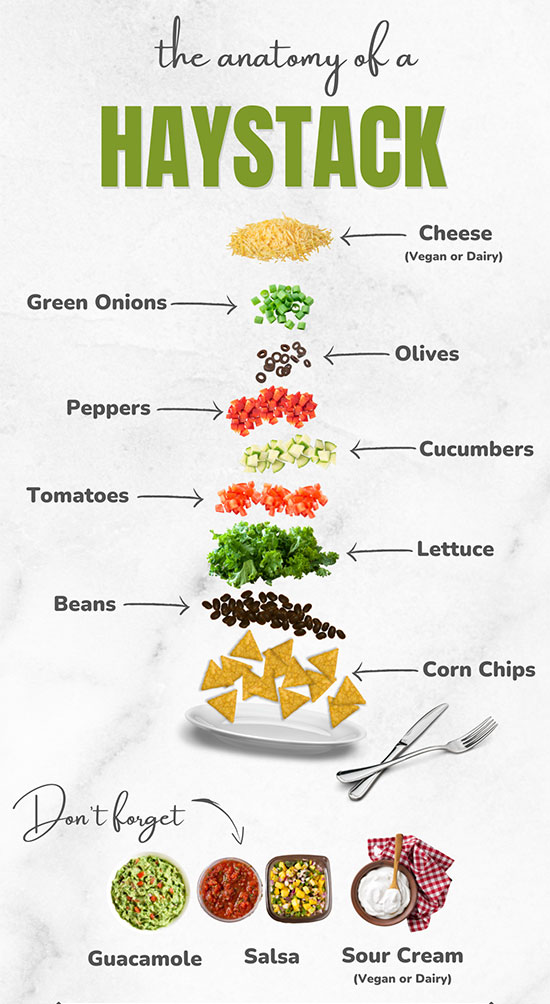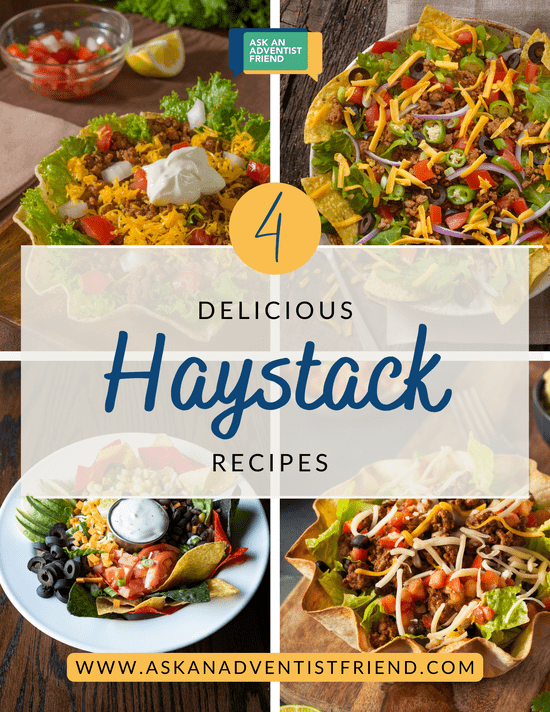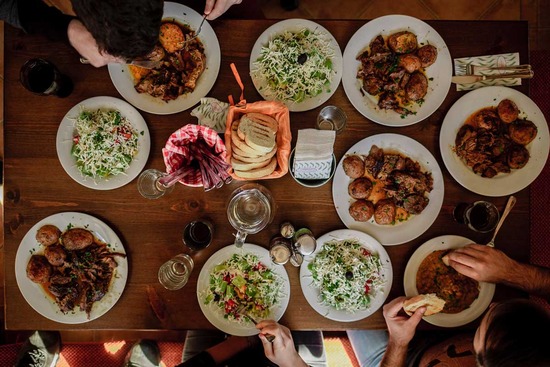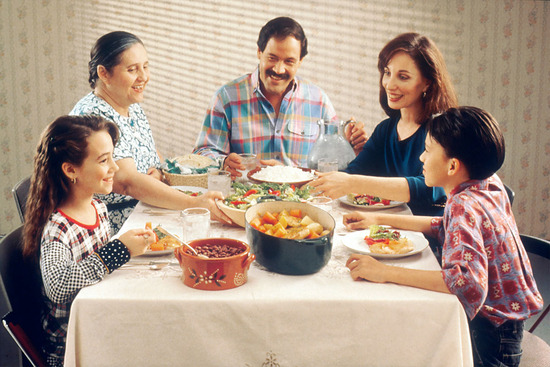If you’ve ever heard Seventh-day Adventists mention “haystacks,” they’re probably not talking about literal stacks of hay.
Haystacks are basically a taco salad—with an Adventist spin on it! Most versions are vegetarian and offer an endless combination of tasty toppings. We eat them often because they’re healthy, scrumptious, and easy to make.
But where exactly did haystacks come from? And who came up with such an unusual name?
Get to know more about this interesting part of Adventist culture in the following sections:
Let’s dig in!
What are haystacks?
Haystacks are a customizable, healthy, and delicious meal often served at Adventist gatherings. They have all the major components of a taco salad for people to assemble themselves. We typically start our haystacks with a bed of corn or tortilla chips, followed by lettuce, beans, cheese, salsa, and sour cream.
Most Adventists make their haystacks vegetarian.
But the great thing about this meal is that it’s customizable. You can make it light or hearty and use any toppings you want for a variety of flavors and textures.
Some might opt for fresh ingredients from the grocery store, but for those on a budget, canned goods work just as well. They don’t require much prep work—you only have to heat up a couple of ingredients. From there, it’s just a matter of placing the toppings in different bowls and letting your guests put it together.
The history of haystacks
The idea for haystacks all began with an Adventist woman named Ella May Hartlein who loved Mexican-inspired food.1
In the 1950s Mrs. Hartlein lived in Arizona, where she and her family enjoyed a variety of Mexican cuisine. But they eventually moved to the northeast, where she couldn’t find many Mexican restaurants.2
That’s when she decided to cook up a little something herself.
She first showcased her dish at a local picnic, and it was an instant hit! After that, it was called “the Hartlein special” until it was given the name “haystacks.”3
How this name came about is still a mystery.
But it’s not hard to guess that haystacks got their name from the way they’re shaped. A big mound of lettuce and crispy corn chips—plus all the toppings—might remind you of a stack of hay.
Turns out, all those toppings do more than add taste. Adventists have some other good reasons for eating them.
Why Adventists eat haystacks
Haystacks are a great meal to have if you’re looking for something quick, easy, and inexpensive. And Adventists especially enjoy them because they offer a healthy meal that coincides with our desire to care for our bodies.

One principle we hold dear is the principle of healthy living. That’s why many of our dishes are plant-based or vegetarian—haystacks included. Plant foods are full of nutrients to effectively fuel our bodies.
Here are just a couple of examples of what you’ll find in haystacks:
- Tomatoes, avocados, and certain beans are high in potassium.4
- Bell peppers are high in vitamin A.5
- Beans and leafy greens are high in6 calcium.
Not to mention that the whole dish is high in fiber and low in cholesterol (or even cholesterol-free if you’re making a vegan version). Beans make it a great protein option, too (especially for vegetarians).
Although not all Adventists are vegetarian, many have benefited from these plant-based benefits. In fact, Adventists are some of the longest living people in the world, mainly because of what we eat.7
Healthy eating matters to us because we want to care for our bodies, which the Bible says are temples of the Holy Spirit:
“Or do you not know that your body is the temple of the Holy Spirit who is in you, whom you have from God, and you are not your own? For you were bought at a price; therefore glorify God in your body and in your spirit which are God’s” (1 Corinthians 6:19–20, NKJV).
Taking care of our bodies is a way to thank God for all He’s done for us. Through healthy habits, we glorify Him, serve Him better, and experience a higher quality of life.
Try haystacks for a simple and healthy meal
Haystacks demonstrate that eating healthy doesn’t have to be difficult or expensive. Something as simple and cheap as this Adventist classic can turn canned vegetables into a satisfying meal you’ll look forward to having again and again.
And it’ll put you on the path to trying some other healthy and delicious meals!
Want the ultimate guide to practical Adventist eating? Look no further than our Adventist nutrition article for practical tips on staying healthy and living longer.
4 Mouthwatering Haystack Recipes
Interested in making haystacks at home? We’ve got four tasty recipes just for you!
Each of these recipes serves about six people. Because they are so simple, they require little to no prep time. Put all of the ingredients in separate bowls so each person can add whichever toppings they want.
Place any perishable leftovers in airtight containers in the fridge. Most of your toppings should last about a week.
The Original
- 4 bags (262 g) of Fritos corn chips
- 1 large can (40.5 oz) of cooked kidney beans
- 1 package (340 g) of veggie taco meat
- 2 bags (227 g) of shredded iceberg lettuce
- 1 small can (6 oz) of sliced black olives
- 1 diced tomato
- 1 diced onion
- 1 bag (226 g) of shredded cheese (dairy or plant-based)
- 1 container (16 oz) of sour cream (dairy or plant-based)
- 1 jar (16 oz) salsa
- 1 container (16 oz) of guacamole
Instructions: Heat up the kidney beans and veggie taco meat. Get a large dinner plate and layer on the ingredients—corn chips first, then the beans, taco meat, lettuce, shredded cheese, vegetables, and toppings. You can use your fork or corn chips to scoop up your haystack.
Pinto Bean Haystack
- 2 large bags of lime tortilla chips
- 3 cups of cooked white rice
- 2 cans (16 oz) of cooked pinto beans
- 1 jar (45 oz) of warm Ragu pasta sauce (tomato, garlic, and onion flavor)
- 1 bag (226 g) of shredded cheese (dairy or plant-based)
- 1 container (16 oz) of sour cream (dairy or plant-based)
- 1 container (16 oz) of guacamole
Instructions: Heat up the white rice, pinto beans, and Ragu sauce. Get a large plate and stack the white rice, pinto beans, Ragu sauce, shredded cheese, sour cream, and guacamole. Mix these ingredients together on your plate and scoop them up with your lime tortilla chips.
Southern Special
- 4 bags (262 g) of Fritos chili cheese corn chips
- 1 can (16 oz) of grilled corn kernels
- 3 cups Spanish rice
- 1 sautéed onion
- 2 sautéed bell peppers
- 2 cans (16 oz) of cooked black beans
- 1 jar (16 oz) of warm queso (or 2 cups of homemade vegan cheese sauce)
- 1 container (16 oz) of sour cream (dairy or plant-based)
- 1 jar (16 oz) of salsa
- 1 container (16 oz) of guacamole
Instructions: Cook the corn, Spanish rice, onions, and peppers. Heat up the black beans and queso. Get a big plate and layer on the ingredients—first with the corn chips, then the Spanish rice, black beans, corn, onions, peppers, and additional toppings. Use a fork or your corn chips to scoop up this tasty meal!
Rainbow Haystacks
- 2 bags of blue corn chips
- 1 can (40.5 oz) of cooked red kidney beans
- 3 cups of cooked brown rice
- 2 bags (227 g) of shredded iceberg lettuce
- 1 sliced head of red cabbage
- 1 diced red onion
- 1 diced tomato
- 2 shredded carrots
- 2 diced orange bell peppers
- 2 bags (226 g) of shredded cheddar cheese (dairy or plant-based)
- 1 bottle (24 oz) of ranch dressing (dairy or plant-based)
- 1 container (16 oz) of sour cream (dairy or plant-based)
- 1 jar (16 oz) of salsa
- 1 container (16 oz) of guacamole
Instructions: Heat up the kidney beans. Get a big plate and stack the toppings. Start with the corn chips, then the rice, beans, lettuce, additional veggies, and final toppings like cheese and sour cream. This is a great option for kids. The rainbow theme can help them overlook the veggies, meaning they get a meal that’s nutritious and fun.
Find a Church
If you’re interested in finding a local Adventist church near you, you can use the Adventist Locator provided by the General Conference of Seventh-day Adventists.
Related Articles
- “Haystacks or Hartlein Special?”Adventist Review, Nov. 26, 2009. https://adventistreview.org/2009-1533/2009-1533-18/archive-2976/.[↵]
- Ibid. [↵]
- Ibid. [↵]
- “10 Foods That Are High in Potassium,” Cleveland Clinic, Feb. 24, 2021. [↵]
- “Vitamin A,” Harvard T.H. Chan School of Public Health. [↵]
- Jennings, Kerri-Ann, “Top 15 Calcium-Rich Foods (Many Are Nondairy),” Healthline, Nov. 4, 2021. [↵]
- “Loma Linda, California,” Blue Zones. [↵]
More Answers
Seventh-day Adventist World Population and Demographics
The Adventist Church has more than 22 million members and 100,000 churches worldwide, plus a large system of hospitals, schools, and publishing houses. Learn more about this diverse church.
What Is a Seventh-day Adventist Camp Meeting?
Although camp meetings didn’t begin with the Seventh-day Adventist Church, they’re as much an Adventist thing as haystacks.
Camp meeting is an extended event for Adventists (and non-Adventists) of all ages to gather and participate in spiritual seminars and activities. During the event, attendees often camp in tents, campers, or RVs.
How to Join the Seventh-day Adventist Church
Whether you heard about the Seventh-day Adventist Church through a traveling evangelist, during your online searches, or through a loved one or relative, you might be considering joining yourself.
How Do Adventists Do Baby Dedications?
For Christians, dedication ceremonies for babies, also for older children, are an important time for parents and the church. It’s a special part of the worship service when parents present their young children to God and the church family. Both parents, along with the congregation, regard this as a solemn promise to be a Christ-like example to the child.
Do Adventists Celebrate Communion and Foot Washing?
Like many Christian denominations, Adventists regularly participate in communion, also referred to as the “Lord’s Supper” or the “Last Supper.” They also practice foot washing (John 13:1-20), or the “ordinance of humility,” during the service—which isn’t as common.
What is the Concept of “Present Truth” and Why is it Important?
Present truth is the principle that certain biblical truths are relevant to God’s people at specific times in history. God sends the Holy Spirit to reveal truths that help us better understand how to interpret and apply His Word in a present moment.
Do Seventh-day Adventists Celebrate Easter
Yes, many Seventh-day Adventists do celebrate Easter.
Does the Adventist Church Have Youth Ministry Programs?
The Seventh-day Adventist Church has been organizing and operating youth ministry programs since 1879.
In our opinion, youth ministry is one of the most important ministries a church can have.
Do Adventists Celebrate Birthdays?
Yes, most Seventh-day Adventists do celebrate birthdays because we see them as excellent reminders of the life God has blessed us with. And we celebrate them the same way everyone else does—with friends, family, presents, and a special meal.
What Do Adventists Offer for Young Adults?
In recent years, the age group often classified as “young adults” has been trickier to engage. It’s been a significant concern for Christian churches around the world. Though interestingly enough, similar observations regarding young adults have been coming up in conversations about the economy, the entertainment industry, politics, and more.
Do I Need to be an Adventist to be Saved?
The answer to this question is simply, “no.”
When it comes to salvation in Jesus Christ, all that is required of a person is to acknowledge Jesus’ sacrifice for us, believe that He has saved us, and claim the free gift of salvation that is always available to us. Salvation is not based on denomination.
Do You Have to Be Vegetarian to Be Adventist?
Of course not. Membership in the Seventh-day Adventist Church has never included any dietary requirements. However, there might be some reasons people might think that. So many Adventists are vegetarians or even vegan, and a plant-based lifestyle has many health benefits.
All About Seventh-day Adventist Colporteurs
The Seventh-day Adventist Church uses a variety of methods to spread the hope of the gospel to the world. One of these ways is through colporteuring, also called “canvassing” or “literature evangelism.”
What Is an Adventist Book Center (ABC)?
When you walk into any one of the many Adventist Book Center (ABC) locations, chances are you’ll be greeted by pleasant gospel music in the background, friendly employees, and row after row of Christian books, movies, Bibles, study guides, kids’ games, and more.
Do Seventh-day Adventists Celebrate Holidays?
Wondering whether your Adventist classmate or coworker keeps the same holidays you do? Perhaps you want to include them in some festivities, but you also want to respect their beliefs. Thus, you’re unsure of how to navigate the holiday question. Will they accept your invitation to the office Christmas party?
Do Seventh-day Adventists Believe in Medical Care?
The Seventh-day Adventist Church believes in and supports evidence-based medical care. In fact, medicine has played a significant part in our history, and today we run a major health system with hospitals, medical schools, and clinics throughout the world.
All about Adventist Elementary Schools
The Seventh-day Adventist Church operates the largest Protestant education system in the world. A big part of this system is our K-8 elementary schools, or primary schools, as they’re known in other parts of the world.
What Are Pathfinder and Adventurer Clubs?
Like the boy or girl scouts, Pathfinders and Adventurers learn about nature and life skills. But what makes these clubs special is their purpose to bring young people closer to Jesus.
A Look at Adventist Colleges and Universities
On the outside, Seventh-day Adventist universities may not look much different than other college campuses. But the real differences are beneath the surface.
What Is ASI (Adventist-Laymen’s Services and Industries)?
ASI, which stands for Adventist-laymen’s Services and Industries, is a membership-based organization that provides support for Seventh-day Adventist laypeople (Adventist professionals who aren’t pastors).
What Are Adventist Evangelistic Meetings?
The Seventh-day Adventist Church puts a huge emphasis on sharing the gospel through evangelism, or sharing the gospel through preaching, teaching, and testimony. One of the ways we accomplish this is by organizing public events called evangelistic meetings.
Christian Summer Camps—A Cherished Adventist Ministry
School’s out, the sun’s shining, and your kids are thrilled to have the summer ahead of them. Then three days in, you hear, “I’m bored…”
Do Adventists Have Their Own Bible?
Adventists have some unique beliefs—you might be able to name some of them right now. The seventh-day Sabbath. Death as a sleep. Hell as nonexistence.
What Is Vespers?
Friday rolls around, and you’re spending time with your Adventist friends or relatives when they mention they’re going to vespers tonight.
Adventist Pastors
What is the role of a pastor in the Adventist Church? The position itself, at least as far as a local congregation is concerned, is not much different from that of pastors in other protestant denominations.
The Leadership Structure of the Seventh-day Adventist Church
The Seventh-day Adventist Church has a representative form of structure that connects its 90,000-plus congregations across the globe and gives its members a part in decision-making. Though the Church was incorporated in 1863, this system came about during the church’s reorganization from 1901 to 1903. It includes four levels of organization.
What to Expect When You Go to an Adventist Church
If you’re attending an Adventist church for the first time, you may wonder what it’s really like. While each Adventist church is unique in its collective personality and local culture, Adventist church services are generally similar to most other Protestant church services.
Adventist Education
Seventh-day Adventists have historically upheld the importance of a well-rounded, high-quality education. Instead of a one-size-fits-all approach to teaching and learning, the Adventist Education system operates on the principle of educating the “whole” person.
Evangelism
Evangelism is simply sharing the truths of the Bible with someone else. And Adventists are all into it.
Didn’t find your answer? Ask us!
We understand your concern of having questions but not knowing who to ask—we’ve felt it ourselves. When you’re ready to learn more about Adventists, send us a question! We know a thing or two about Adventists.


































